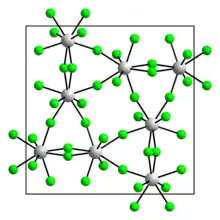 | |
| Identifiers | |
|---|---|
3D model (JSmol) |
|
PubChem CID |
|
| |
| |
| Properties | |
| F5Pa | |
| Molar mass | 326.02790 g·mol−1 |
| Appearance | white solid[1] |
| Soluble in water and hydrofluoric acid[1] | |
| Related compounds | |
Other anions |
protactinium(V) chloride protactinium(V) bromide protactinium(V) iodide |
Other cations |
uranium(V) fluoride |
Related compounds |
protactinium(IV) fluoride |
Except where otherwise noted, data are given for materials in their standard state (at 25 °C [77 °F], 100 kPa).
Infobox references | |
Protactinium(V) fluoride is a fluoride of protactinium with the chemical formula PaF5.
Preparation
Protactinium(V) fluoride can be obtained by reacting protactinium(V) oxide with bromine trifluoride or bromine pentafluoride at 600 °C:[1]
It can also be obtained by reacting protactinium(V) chloride or protactinium(IV) fluoride with fluorine gas at 700 °C:[1]
The hydrate form of protactinium(V) fluoride can be formed by the reaction of protactinium(V) oxide and hydrofluoric acid in an aqueous solution:[1]
It can also be decomposed from fluorine-containing protactinium complexes.[2]
Properties
Protactinium(V) fluoride is a white, volatile, extremely hygroscopic solid that is partially soluble in water and soluble in hydrofluoric acid. It has a tetragonal crystal structure of the β-uranium pentafluoride type with the space group I42d (space group no. 122) with the lattice parameters a = 1153 pm, c = 510 pm. Quartz and Pyrex are attacked by the compound at higher temperatures. As a dihydrate, it is a colourless, hygroscopic, crystalline solid that is waxy in nature. It is soluble in water and hydrofluoric acid.[1] It reacts with phosphorus trifluoride to form protactinium(IV) fluoride.[3] The dihydrate cannot be converted into the anhydrous form in air, hydrogen fluoride or fluorine at low temperatures. Instead, diprotactinium(V) oxide octafluoride (Pa2OF8) is formed. At higher temperatures around 325 °C, a mixture of the diprotactinium(V) oxide octafluoride and protactinium(V) fluoride is formed.[2]
References
- 1 2 3 4 5 6 Handbuch der Präparativen Anorganischen Chemie. p. 1170. ISBN 3432023286.
- 1 2 G. Meyer; Lester R. Morss (1991). Synthesis of Lanthanide and Actinide Compounds (in German). Springer. p. 77. ISBN 9780792310181.
- ↑ Lester R. Morss; Norman M. Edelstein; J. Fuger, eds. (2010). The Chemistry of the Actinide and Transactinide Elements (in German). Vol. 1. Springer. p. 198. ISBN 978-94-0070211-0.